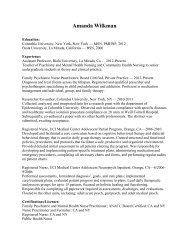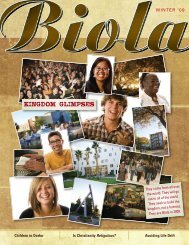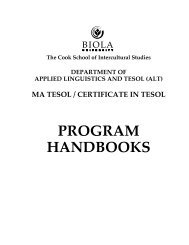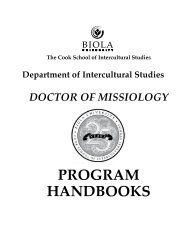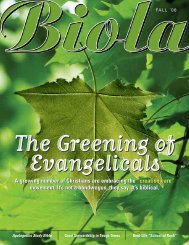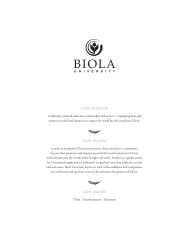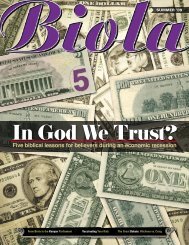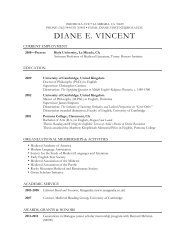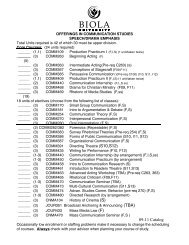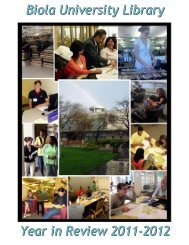Brian McLaren's Theology Visual Arts and the Bible - Biola University
Brian McLaren's Theology Visual Arts and the Bible - Biola University
Brian McLaren's Theology Visual Arts and the Bible - Biola University
You also want an ePaper? Increase the reach of your titles
YUMPU automatically turns print PDFs into web optimized ePapers that Google loves.
06 READER MAIL BIOLA CONNECTIONS ❄ WINTER ’06<br />
Argument From Silence<br />
Dr. Tuggy [“Reader Mail,” Fall 2005], apparently, thinks that some are backing away from <strong>the</strong><br />
doctrine of inerrancy because <strong>the</strong> <strong>Bible</strong> contains errors. Dr. Tuggy cites as an example <strong>the</strong><br />
comparison of Mat<strong>the</strong>w 21:1-8. If <strong>the</strong> reader looks at Mat<strong>the</strong>w 21:2, Jesus tells <strong>the</strong> disciples to go<br />
get a donkey <strong>and</strong> her colt. In <strong>the</strong> Mark <strong>and</strong> John renditions, <strong>the</strong> disciples are simply told that <strong>the</strong>y<br />
will find a colt. On <strong>the</strong> surface, this appears to be a contradiction. However, examination of <strong>the</strong> Mark<br />
<strong>and</strong> John accounts shows that <strong>the</strong> writer simply focused on <strong>the</strong> chief figure — <strong>the</strong> colt Jesus would<br />
ride. This is a common literary practice of this time. If Mark or John had said <strong>the</strong> disciples found only<br />
a colt, or that Jesus told <strong>the</strong> disciples <strong>the</strong>y would find only a colt, <strong>the</strong>re would be a contradiction. But<br />
<strong>the</strong> fact that both animals are not mentioned is only an apparent error <strong>and</strong>, to apply it to <strong>the</strong> inerrancy<br />
doctrine, is an argument from silence. Without a doubt, <strong>the</strong> <strong>Bible</strong> has divergences <strong>and</strong> difficulties.<br />
But <strong>the</strong>se are not necessarily errors or contradictions. I suggest Geisler <strong>and</strong> Howe’s When Critics<br />
Ask: A Popular H<strong>and</strong>book on <strong>Bible</strong> Difficulties.<br />
Keith Wells (M.A. ’02; current student)<br />
Chino Hills, Calif.<br />
Impressed By Tuggy’s Letter<br />
I was impressed by <strong>the</strong> article “An Errant<br />
St<strong>and</strong>?” in <strong>the</strong> fall 2005 edition of <strong>Biola</strong><br />
Connections because it brought something to<br />
my attention that I had read many times but<br />
missed. I had never noticed that Mat<strong>the</strong>w<br />
mentioned more than one animal when <strong>the</strong><br />
Lord entered Jerusalem on Palm Sunday in<br />
contrast to Mark <strong>and</strong> John who had both<br />
mentioned only one. Events like this impress<br />
me because <strong>the</strong>y make me aware of how much<br />
I am still missing in <strong>the</strong> Word of God. I owe Dr.<br />
Dale Tuggy a debt of gratitude for bringing this<br />
to my attention. This discrepancy could be an<br />
issue of concern until you realize that <strong>the</strong> Lord<br />
rode only one of <strong>the</strong> two animals mentioned in<br />
Mat<strong>the</strong>w. That fulfilled Zechariah 9:9.<br />
Mat<strong>the</strong>w simply gave more information on<br />
this incident than did Mark or John.<br />
Larry Rodgers (’70)<br />
Whittier, Calif.<br />
Giving Up on <strong>the</strong> <strong>Bible</strong> Too Easily<br />
Unfortunately for Tuggy’s argument, <strong>the</strong><br />
alleged <strong>Bible</strong> error he chooses is easily<br />
explained. Mark, along with Ma<strong>the</strong>w,<br />
understood <strong>the</strong> parallelism in Zechariah 9:9<br />
as describing <strong>the</strong> sort of donkey Jesus would<br />
ride. Ma<strong>the</strong>w simply elaborates on <strong>the</strong><br />
Messiah’s triumphal entry by including <strong>the</strong><br />
mo<strong>the</strong>r of <strong>the</strong> colt. The passages do not<br />
infer that Jesus rode two donkeys, but that he<br />
chose one to sit on. Both Mark <strong>and</strong> Ma<strong>the</strong>w<br />
contain a picture of Jesus riding a donkey:<br />
<strong>the</strong>refore, no proof remains that is in conflict<br />
with ei<strong>the</strong>r author’s interpretation of<br />
Zechariah 9:9. I question <strong>the</strong> intentions of<br />
someone who supposedly “strives to base his<br />
<strong>the</strong>ology <strong>and</strong> spiritual life on those precious,<br />
revealed books” while planting doubt in a<br />
believer based on a weightless “error” that<br />
has been explained in many books <strong>and</strong><br />
commentaries. Truly, those who consider<br />
<strong>the</strong>mselves Christians should not give up on<br />
<strong>the</strong> <strong>Bible</strong> so easily.<br />
Andrew Schaeffer,<br />
Solvang, Calif.<br />
Succumbing to Political Correctness<br />
<strong>Biola</strong> <strong>University</strong> has come too far in its<br />
scholarly pursuit to now succumb to <strong>the</strong> P.C.<br />
mentality of Professor Christerson [“Professor<br />
Examines Church Diversity,” Fall<br />
2005]. Diversity by definition is inherently<br />
racial discrimination. If one does not accept<br />
this, <strong>the</strong>n note his example of “integrated<br />
leadership”: “a white pastor, an African<br />
American pastor, <strong>and</strong> a Hispanic pastor.” As<br />
to his second point, where is <strong>the</strong> diversity of<br />
“help those in <strong>the</strong> minority ... connect with<br />
o<strong>the</strong>rs of <strong>the</strong>ir own ethnic group”? As to his<br />
third point, “intentionally teach members to<br />
value <strong>the</strong> diversity (emphasis mine) in God’s<br />
creation <strong>and</strong> kingdom.” I do wonder how<br />
elementary I should get in countering<br />
[Christerson], yet I find myself constrained<br />
to point out that Paul, writing in <strong>the</strong> Galatian<br />
epistle (3:26-28), made it abundantly clear<br />
that we are not to see each o<strong>the</strong>r as ethnically<br />
distinct (“There is nei<strong>the</strong>r Jew nor Greek”),<br />
socially distinct (“<strong>the</strong>re is nei<strong>the</strong>r slave nor<br />
freeman”), or gender distinct (“<strong>the</strong>re is<br />
nei<strong>the</strong>r male nor female”). Finally, “<strong>the</strong><br />
church should not be homogeneous.” If this<br />
had been <strong>the</strong> modus oper<strong>and</strong>i in church missions<br />
through church history, [Christerson]<br />
would probably not be <strong>and</strong> nei<strong>the</strong>r would<br />
<strong>the</strong>re have been a <strong>Biola</strong>.<br />
Dr. Bruce Kohfield (’59)<br />
Dublin, Calif.<br />
T E L L U S W H A T Y O U T H I N K ! — E-MAIL: connections@biola.edu — MAIL: Reader Mail, <strong>Biola</strong> Connections, 13800 <strong>Biola</strong> Avenue, La Mirada, CA 90639<br />
FAX: (562) 906-4547 Opinions should be a maximum of 200 words <strong>and</strong> include full name, city <strong>and</strong> state, <strong>and</strong> class year (if applicable). They may be edited for length <strong>and</strong> clarity.



